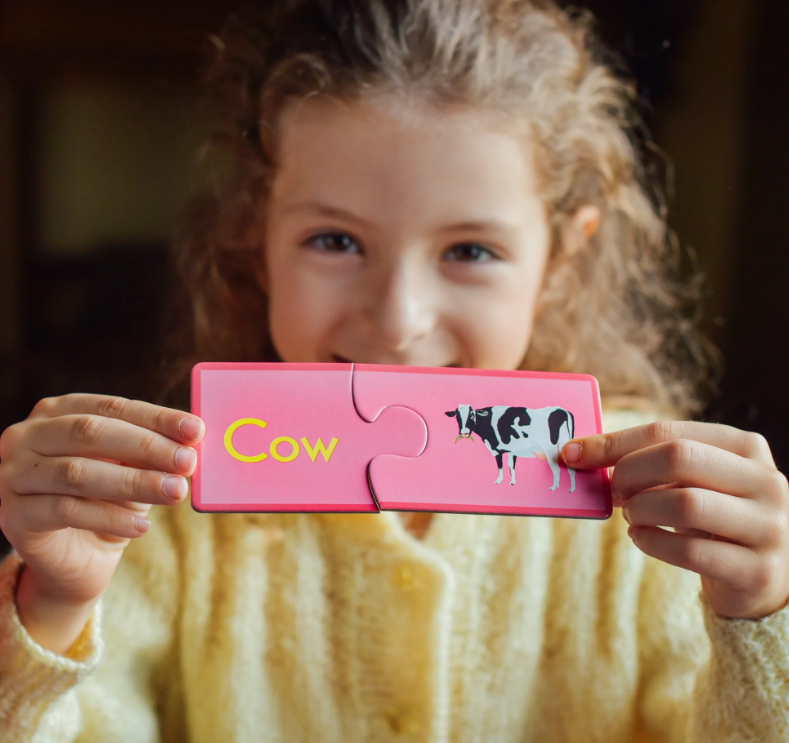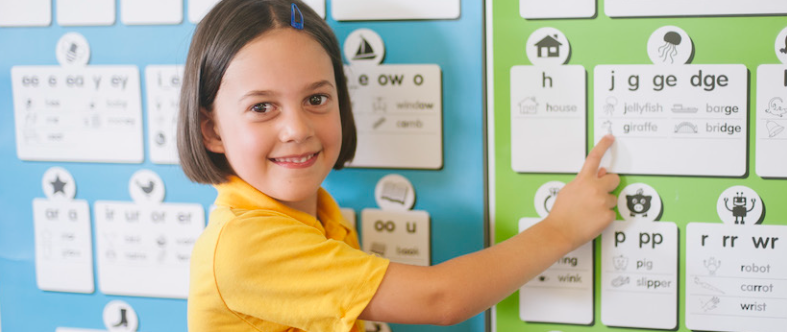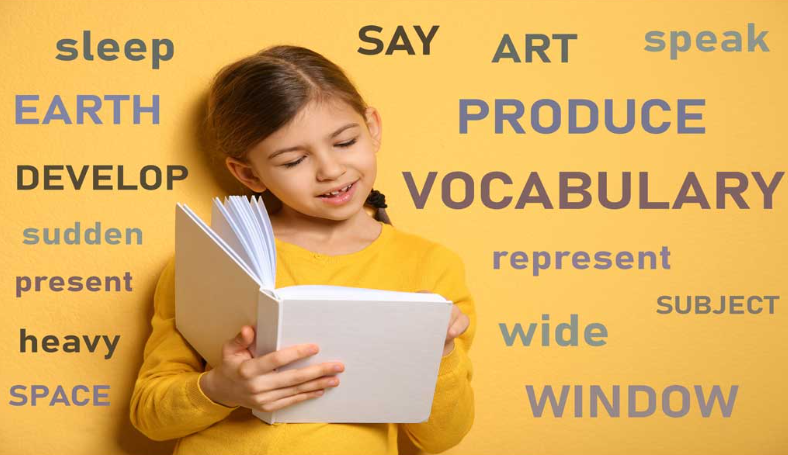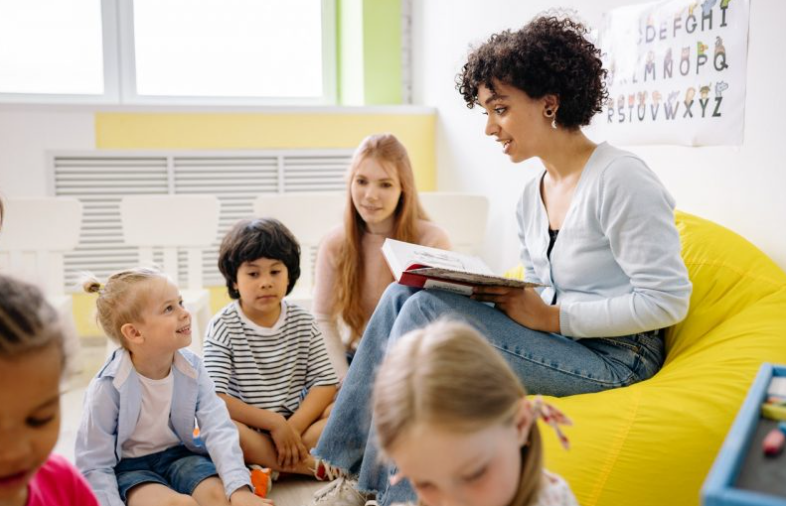The value of language development in children cannot be undervalued, as it forms the base for communication, cognitive development, and social interaction.
Among the lush vocabulary lies a cozy world of ease—simple words made for a child’s mind, which they use as stepping stones on their linguistic journey.
Knowing simple words not only gives them the ability to express what they think and feel but also affords them the feeling of confidence and accomplishment.
This article touches on the magical world of language learning, discussing the simple words for kids to learn and investigating how we can cultivate the linguistic roots of the young saplings.
Criteria for Easy Words
With young minds starting their linguistic adventures, using easy words dramatically influences how they express themselves, think, and become more competent language speakers.
A clear perception of the requirements for picking up easy words is crucial to undertake this pivotal mission successfully.
Presented here is the delicate part of the lexical choice, dealing with those components that make the words appealing and beneficial for young learners.
1. Short Length and Simple Sounds:
Simplicity and brevity are the essence of easy words. By nature, short words with simple sounds are more understandable and easy to articulate by preschool children.
Monosyllable words like “cat,” “dog,” and “ball” are instances of this rule in action. Their short form makes it possible to keep the cognitive load low and pronunciation accessible for new speakers.
Also, words with simple phonetic structures, without clusters of difficult consonants or irregular combinations of vowels, tend to be more understandable to young learners.
For example, words like “sun,” “run,” and “cup” reflect clear and meaningful phonetic qualities that a child can use for pronunciation or even general speaking.
2. High Frequency in Everyday Language:
Frequency is among the most critical factors that affect language development.
The vocabulary used to communicate the basics offers more reinforcement and practice opportunities, leading to faster learning.
The many phrases that adults use, like “mom,” “dad,” “hello,” and “bye,” are heard by the children every day, giving them something from which to build communication.
Educators’ application of high-frequency expressions guarantees that children have a vocabulary relevant to their social affairs and everyday lives.
This familiarity promotes comprehension and may be the basis of mastery of verbal structure, confidence, and fluency.
3. Relevance to the Child’s Environment and Experiences:

The bond between language and experience is solid, feeding into the child’s perception of the world and its place within it.
To this effect, precaution must be taken when selecting the most familiar words to describe the child’s environment and experience.
Children would be more interested and find the words used to describe the known objects, actions, and concepts more meaningful.
For instance, words like “bed,” “eat,” “play,” and “rain” help to re-create children’s routines, activities, and environment.
This enables the experience to be very real, making the experience one with significant meaning and understanding.
Providing vocabulary teaching in the context of the child’s personal experience may improve the quality of learning and bridge the gap between words and reality.
4. Concrete and Tangible Concepts:
In the initial stage of language development, children are attracted to concrete and fundamental concepts they can see, touch, and experience with their senses.
Thus, language expressions that indicate concrete things, actions, and attributes are instrumental for children to learn.
Such concrete nouns as “car,” “tree,” “ball,” and “house” make it possible for children to concretize their abstractions and ground their understanding based on reality.
Similarly, verbs of action such as “run,” “jump,” “eat,” and “sleep” give children a chance to share their actions and intentions clearly and consciously.
Through targeted vocabulary, educators set a broad linguistic foundation instrumental in facilitating understanding, communication, and cognitive growth.
5. Multisensory and Interactive Learning Opportunities:

The use of multisensory learning environments is a model that combines language acquisition and communication, which improves the empowerment of language learning.
Mixing of practical activities that are participatory with the audience offers a guarantee of understanding literacy, which is essential in maintaining engagement.
Integrated verbal-gestural cues that include graphics and physical objects as assistants strengthen knowledge and improve understanding.
Furthermore, the inbuilt activities foster speaking, listening, collaborating, and socially interacting skills for the children; thus, the children’s experiences are colorful and enjoyable.
Multisensory, interactive, and whole-group teaching strategies allow the teacher to make the classroom a language-rich environment where students can learn and grow.
6. Positive Emotional Association:
The emotional tone associated with language acquisition dramatically impacts a child’s attitude toward acquiring the language.
Inducing the positive mood and motivation of the learner is achieved by selecting easy words that evoke positive emotions and experiences.
Phrases like “love,” “friend,” and “fun” not only evoke positive emotions but also generate a pleasant ambiance for children to experience the power of language.
Building a favorable emotional relation with the words stimulates motivation, curiosity, and a passion for using the language for discovery.
Categories of Easy Words
The use of primary vocabulary groups is integral in not only developing the linguistic structure of budding writers but also acts as a basis for linguistic eagerness.
Here are various categories of easy vocabularies that provide means of radical learning and language development.
1. Basic Nouns: Objects, Animals, and People
One of the fundamental constituents of the base of early language learning is nouns.
This is to mention things, animals, and people that a child interacts with daily and shape his/her understanding of the environment.
Nouns like “ball,” “cat,” and “mom” are common names of things that are easily understood and referred to.
By applying these words, educators and caregivers give the children the skills to identify and label their surroundings appropriately.
Concrete nouns narrow the gap between language and reality and thus provide a firm foundation for the other advanced language concepts to be mastered in the future.
2. Action Verbs: Simple Activities
Language develops through action, and verbs in the category of action verbs serve to depict the dynamics of simple actions.
With these words, children can share their experiences and understand what is happening around them.
Verbs like “run,” “eat,” and “play,” to name a few, are action words that give children words that describe their lived experiences in many colors and details.
As children participate in activities, these words become the cords that connect the parts of their expressive fiber, enabling this flow from description to communication.
3. Adjectives: Descriptive Words
Adjectives inject a dash of color and specifics into the rainbow of language.
Simple adjectives add details to words, and children can visualize scenes more compellingly with the abundance of words.
“Large,” “hot,” and “soft” are among the adjectives that give the child’s language colorfulness, allowing them to talk about size, temperature, and texture in a clear way.
Using adjectives in children’s language while discovering the world around them develops not only their expressive capacities but also their perceptive ones so that they become more discerning of the surrounding reality.
4. Prepositions: Basic Position Words
The introduction of prepositions makes it an interesting linguistic challenge to negotiate the space and relationships in it.
These words indicate the most fundamental spatial concepts, and children apply them to determine the position of the objects around them.
“In,” “on,” and “under” are some of the most common prepositions that help express their relative position to the referenced items.
With these words, young minds become aware of location, direction, and relationships, which, in turn, creates a basis for more complicated forms of communication to be generated later in the future.
5. Pronouns: Simple Personal Pronouns
The use of pronouns as linguistic tools in the course of interpersonal communication should not be underestimated.
These pronouns like “I,” “you,” “he,” and “she” that we efficiently use make the shift from self-reference to addressing others to be smooth.
Pronouns help to improve the fluency and the fluency of the language, enabling children to communicate more concisely and interact with others successfully.
These words mark a significant step in the child’s social language development and equip them with a fundamental skill to navigate social identity and relationships.
6. Numerals: Basic Counting Words
Numerals are a universal language, and simple words within the numeral group assist kids in grasping the essence of quantification.
These words that range from “one” to “ten” and beyond act as a basis for numeracy.
Writing numbers not only helps children to describe quantities in words but also is the first step in understanding basic mathematical principles.
Reciting words that may be quickly learned will encourage the child to explore numbers and begin a process that will give the child a chance to build a solid foundation for the later development of more complex mathematical notation.
7. Conjunctions: Connecting Words

Concise words in the category of conjunctions reflect the language arts of integration and unification.
Such words as “and,” “but,” and “or” are the building blocks as well as the corners connecting sentences and clauses.
While children advance in their linguistic path, adding conjunctions allows them to express more intricate and cohesive sentences.
Conjunctions not only help to make communication well structured but also give the chance to better understand the connections between different parts of a sentence.
8. Interjections: Expressive Utterances
Language is not only a tool for communication but also a medium that allows emotions and reactions to be expressed.
The simple words in the interjection category allow children to express themselves quickly without thinking.
Depictive expressions like “wow,” “oh,” and “yay” help children express their emotions like enthusiasm, amazement, or joy when they talk.
Interjections render language dynamic and emotionally charged, enticing children to tap into the rich expressiveness of words beyond mere literal meanings.
Teaching Methods
Educators and caregivers are the key players in this linguistic journey. They use creative and effective teaching methods to engage young learners and retain the information.
Here is a collection of teaching strategies that will not only simplify the process of learning essential words but will also make this process enjoyable for the kids.
1. Using Visual Aids and Real-Life Objects:
Visual aids and everyday objects are the best assistants they need while they learn how to memorize the words.
Educators exploit the natural curiosity of young minds by using pictures, flashcards, and actual objects to add a visual component to the words being taught.
For example, making an association between the word “apple” and a visual sensory image or showing an apple as it is launching a multisensory activity in which one can actually see, touch, and even taste the object.
Offering visual illustrations creates contextual, meaningful, and concrete connections that allow the child to remember these words permanently while making understanding more accessible.
2. Engaging in Interactive Activities and Games:
Education through play is a cardinal aspect of childhood, and bringing in interactive games and activities makes the process fun and more like an adventure.
Engaging in vocabulary activities such as scavenger hunts, word bingo, and matching games not only aids retention but also makes the learning process interactive and fun.
While playing, children unconsciously assimilate the basic vocabulary related to the words in contact with the positive feelings associated with the play.
Apart from matching various learning styles, these activities also encourage social interaction and collaboration and help children develop mental capabilities, thus making language acquisition an exciting practice.
3. Incorporating Words into Songs and Stories:
The sound of pleasant songs and the hypnotic narrative stories stimulate children’s minds, creating a captivating environment where some words can be easily introduced.
Creating simple and catchy songs consisting of everyday words or using specific vocabulary in familiar songs allows the young to deal with words and language without much struggle.
In addition, incorporating familiar words into stories based on our reading aloud or developing them makes language learning story-based learning.
This emotional attachment through music or storytelling improves memory while creating a positive link to language, thus rekindling a love for language.
4. Encouraging Repetition and Practice:
Repeating is the best way to reach the stage of proficiency. In fact, among the widely used teaching methods is the one that requires kids to repeat and practice simple words.
Chanting, reading, and doing interactive exercises help improve the strength of the neural connections, allowing for better memorization, recall, and automatic language usage.
To ensure that the children understand and memorize the jargon, the words are repeated with different contexts; this way, they might recognize and keep them as part of their vocabulary.
Continuous drilling of new words through formal exercises or just casual talks is a way in which the children gain confidence to use all the terms they wish to.
5. Leveraging Technology:
In the age of digital technology, technology is a good assistance for teaching simple words to kids.
Educational apps, interactive online games, and multimedia resources cater as dynamic and visual platforms for language learning.
Technology integration allows educators to meet students’ personal preferences of the learners while at the same time fulfilling the educational objectives.
Multi-functional apps combining visual graphics and engaging exercises can serve as tools for teachers, complementing classic teaching techniques and providing a unique opportunity to mix various teaching methods.
6. Personalizing Learning Experiences:
The recognition of the individuality of each learner and tailoring instruction according to their varying needs is one of the indicators of effective teaching.
Personalized learning experiences are made by taking into account the interests, strengths, and learning styles of every child.
It may be achieved by using thematic units related to the child’s interests or by integrating easy words connected to the child’s experiences in the language learning process.
By attaching relevant words to a child’s world, educators create a feeling of ownership and enthusiasm for learning.
Tips for Parents and Educators
While parents and instructors start their journey of teaching easy words to toddlers, they serve as critical actors who lay a solid foundation for the future language landscape.
Let us explore a wealth of techniques crafted exclusively for parents and educators who seek to build a lasting passion for language and a command of simple words in kids.
1. Creating a Language-Rich Environment:

The practice of exposing children to an environment rich in the language also provides a complementary device to teaching the instruction of targeted language.
Writing some words in places where children can see them by using labels, posters, and print-rich materials will create consistent exposure to simple words.
In the teaching environment, labeling real-world objects, making word walls, and using language in everyday activities foster a language-rich environment.
A language-rich environment encourages spontaneous language use, develops an interest in words, and focuses on the importance of common words in the child’s life.
2. Provide Positive Reinforcement and Feedback:
Positive reinforcement is one of the most effective motivating factors for parents and teachers to make their children enthusiastic about learning.
Parents and teachers should not only give appreciation to big efforts that lead to a victory but also should be supportive and praise language achievements, even the little effort made.
Positive reinforcement builds self-confidence and a positive attitude to learning regardless of whether a child successfully identifies a new word, engages in conversations, or shows emotions in language.
Having verbal encouragement along with concrete awards could make a good combination that ensures the language is taken seriously and inspires more adventures.
3. Be Patient and Responsive to the Child’s Pace:
Children learn their language at different rates, and therefore, patience is essential when helping them access some simple words.
Both parents and educators must recognize and respect each child’s different pace, giving them space for exploration and natural curiosity.
Other children may grasp some words quickly, while others may need more time; repeated mentions would be helpful in such cases.
The combination of patience and also considering the child’s cues and interests will make the process amusing and stress-free while serving as the basis of a positive attitude towards language.
4. Read Aloud and Share Stories:
Reading aloud to children has been a time-honored tradition that fosters their language development and interest in literature.
It is essential for parents and teachers to constantly make shared reading experiences, choosing books that possess easy-to-understand words along with appealing images.
Storytelling, with its cadence and rhythm, is often hypnotic to young people, and the exposure to a myriad of vocabulary words adds to their linguistic competence.
Asking children to ask questions besides predicting outcomes and discussing the book increases understanding and transforms reading into a group language-learning activity.
5. Expand Vocabulary Gradually:
Although it is vital to introduce new words, you should bear in mind that vocabulary should also be developed gradually, taking into account the child’s development.
Teachers and parents may start with a few simple words, and later, they can introduce more complex ones once the child becomes more acquainted and more confident.
Thematic sets, e.g., colors, numbers, or daily routines, could be introduced to the learner systematically to help expand the vocabulary.
Coming across new words added to vocabulary in different situations motivates children to learn them better, and as a result, they get a strong foundation for their future language.
6. Create Meaningful Connections:
Pairing the essential words with the hopefully most relevant experiences and concepts adds to the children’s learning process.
Parents and teachers can use everyday happenings to help children directly link words and real-world experiences.
Be it a trip to the grocery store or a re-telling of an event, using familiar words will make your little one move towards getting new words and making them an experience-oriented individual.
These bonds not only help one comprehend the content better but also give him a sense of structure and practice in language learning.
7. Foster a Love for Curiosity and Questioning:

Asking questions and showing curiosity are some of the most essential aspects of language development.
Parents and teachers should be proactive by creating an atmosphere where asking questions is encouraged and rewarded.
Through conversations that foster inquiry and exploration, adults assist the children in searching for answers and enhance understanding.
Conclusion
Simple words are like the stepping stone for young minds, showing them the way into the wonderful world of communication.
As parents and teachers, our role goes beyond instruction; it includes consistent follow-up and involvement in the linguistic journey of the child.
Boosting sustained support launches language learning as a pleasant and dynamic experience as children march through the journey at their own pace and interest.
Have a joyful and uplifting journey with us as we walk through the transformation by appreciating the beauty in simplicity and the unlimited possibilities of every simple word.
To make your child’s language acquisition more efficient and fun, try Callie’s kid-adaptable reusable alphabet and number tracing dry-erase board.
This educational gift uses a practical method of learning both letters and numbers while immersing the child in interactive engagement.
Designed with care and thoughtfulness, this dry-erase board encourages kids to trace and practice while reinforcing easy words in a fun and engaging way.



